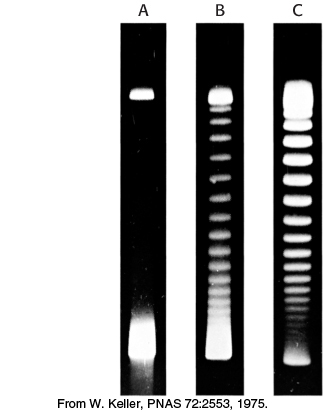PROBLEMS
PROBLEMS
Question 28.1
Activated intermediates. DNA polymerase I, DNA ligase, and topoisomerase I catalyze the formation of phosphodiester bonds. What is the activated intermediate in the linkage reaction catalyzed by each of these enzymes? What is the leaving group?
Question 28.2
Life in a hot tub. An archaeon (Sulfolobus acidocaldarius) found in acidic hot springs contains a topoisomerase that catalyzes the ATP-
Question 28.3
Which way? Provide a chemical explanation of why DNA synthesis proceeds in a 5′-to-
Question 28.4
Nucleotide requirement. DNA replication does not take place in the absence of the ribonucleotides ATP, CTP, GTP, and UTP. Propose an explanation.
Question 28.5
Close contact. Examination of the structure of DNA polymerases bound to nucleotide analogs reveals that conserved residues come within van der Waals contact of C-
Question 28.6
Molecular motors in replication.
How fast does template DNA spin (expressed in revolutions per second) at an E. coli replication fork?
What is the velocity of movement (in micrometers per second) of DNA polymerase III holoenzyme relative to the template?
Question 28.7
Wound tighter than a drum. Why would replication come to a halt in the absence of topoisomerase II?
Question 28.8
The missing link. One form of a plasmid shows a twist of Tw = 48 and a writhe of Wr = 3.
What is the linking number?
What would the value of writhe be for a form with twist Tw = 50 if the linking number is the same as that for the preceding form?
Question 28.9
Telomeres and cancer. Telomerase is not active in most human cells. Some cancer biologists have suggested that activation of the telomerase gene would be a requirement for a cell to become cancerous. Explain why this might be the case.
Question 28.10
Backward? Bacteriophage T7 helicase moves along DNA in the 5′-to-
Question 28.11
Nick translation. Suppose that you wish to make a sample of DNA duplex highly radioactive to use as a DNA probe. You have a DNA endonuclease that cleaves the DNA internally to generate 3′-OH and 5′-phosphoryl groups, intact DNA polymerase I, and radioactive dNTPs. Suggest a means for making the DNA radioactive.
Question 28.12
Revealing tracks. Suppose that replication is initiated in a medium containing moderately radioactive tritiated thymine. After a few minutes of incubation, the bacteria are transferred to a medium containing highly radioactive tritiated thymidine. Sketch the autoradiographic pattern that would be seen for (a) undirectional replication and (b) bidirectional replication, each from a single origin.
Question 28.13
Mutagenic trail. Suppose that the single-

What are the plausible codon assignments for these four amino acids?
Question 28.14
Induced spectrum. DNA photolyases convert the energy of light in the near-
858
Question 28.15
Missing telomerase. Cells lacking telomerase can grow for several cell divisions without obvious defects. However, after more cell divisions, such cells tend to show chromosomes that have fused together. Propose an explanation for the formation of the chromosomes.
Question 28.16
I need to unwind. With the assumption that the energy required to break an average base pair in DNA is 10 kJ mol−1 (2.4 kcal mol−1), estimate the maximum number of base pairs that could be broken per ATP hydrolyzed by a helicase operating under standard conditions.
Question 28.17
Triplet oxidation. The oxidation of guanine bases in the context of triplet repeats such as CAGCAGCAG can lead to the expansion of the repeat. Explain.
Mechanism Problem
Question 28.18
A revealing analog. AMP-
Data Interpretation and Chapter Integration Problems
Question 28.19
Like a ladder. Circular DNA from SV40 virus was isolated and subjected to gel electrophoresis. The results are shown in lane A (the control) of the adjoining gel patterns.

Why does the DNA separate in agarose gel electrophoresis? How does the DNA in each band differ?
The DNA was then incubated with topoisomerase I for 5 minutes and again analyzed by gel electrophoresis with the results shown in lane B.
What types of DNA do the various bands represent?
Another sample of DNA was incubated with topoisomerase I for 30 minutes and again analyzed as shown in lane C.
What is the significance of the fact that more of the DNA is in slower-
moving forms?
Question 28.20
Ames test. The illustration below shows four petri plates used for the Ames test. A piece of filter paper (white circle in the center of each plate) was soaked in one of four preparations and then placed on a petri plate. The four preparations contained (A) purified water (control), (B) a known mutagen, (C) a chemical whose mutagenicity is under investigation, and (D) the same chemical after treatment with liver homogenate. The number of revertants, visible as colonies on the petri plates, was determined in each case.
What was the purpose of the control plate, which was exposed only to water?
Why was it wise to use a known mutagen in the experimental system?
How would you interpret the results obtained with the experimental compound?
What liver components would you think are responsible for the effects observed in preparation D?
